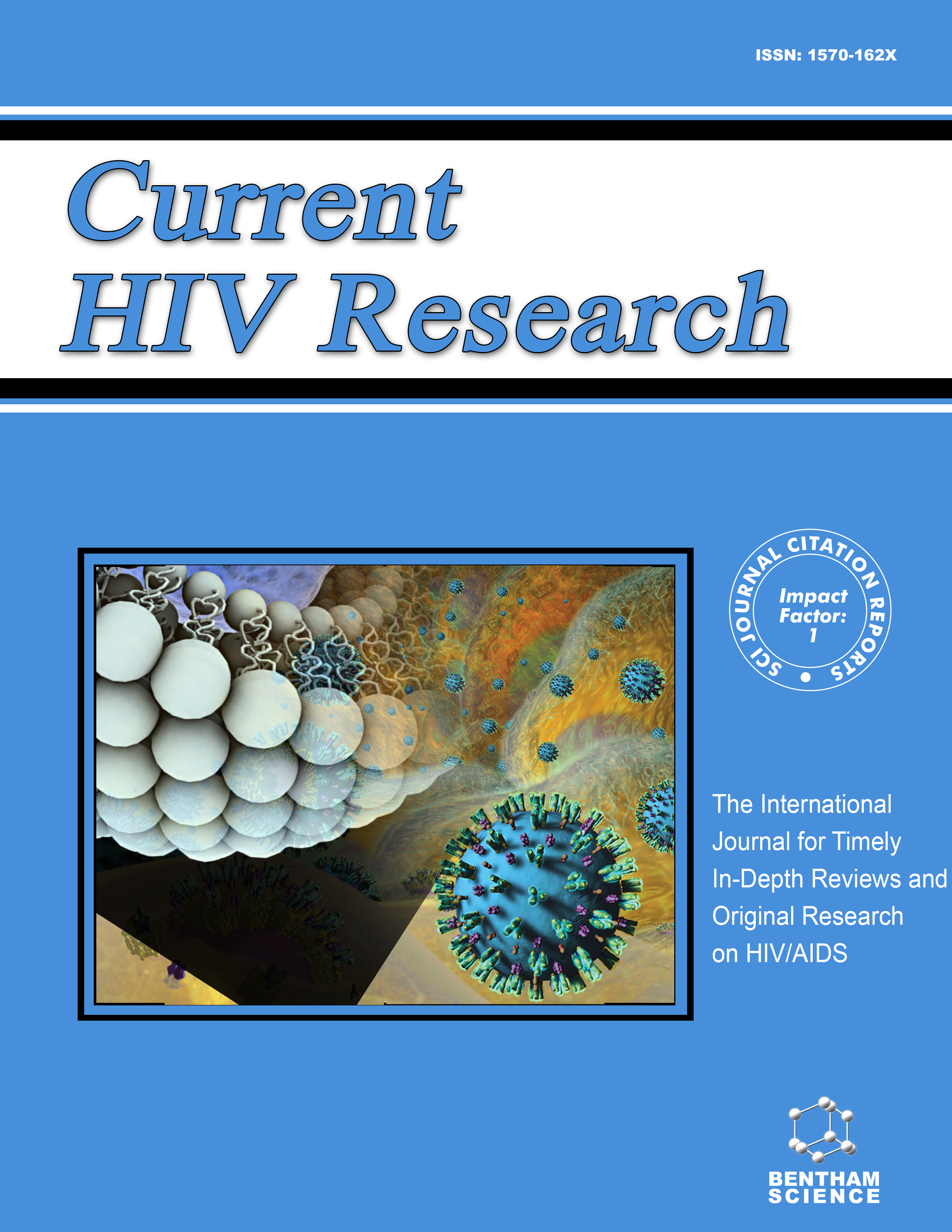- Home
- A-Z Publications
- Current HIV Research
- Previous Issues
- Volume 14, Issue 3, 2016
Current HIV Research - Volume 14, Issue 3, 2016
Volume 14, Issue 3, 2016
-
-
Anti-HIV Factors: Targeting Each Step of HIV’s Replication Cycle
More LessAuthors: Marta Colomer-Lluch, Lauren S. Gollahon and Ruth Serra-MorenoBackground: Similar to other animal viruses, HIV-1 relies on the contributions of the cellular machinery to ensure efficient virus propagation. However, human cells have evolved refined mechanisms to block key steps of the virus life-cycle, thereby suppressing viral replication. These cellular proteins are generally known as restriction factors, and they provide an early antiviral defense. So far, five potent restriction fac Read More
-
-
-
The Early Bird Catches the Worm – Can Evolution Teach us Lessons in Fighting HIV?
More LessAuthors: Torsten Schaller and Nikolas HeroldBackground: Human immunodeficiency virus 1 (HIV-1) infection is the primary cause of the acquired immunodeficiency syndrome (AIDS). Worldwide, approximately 37 million people are infected (UNAIDS, 2014), most of them in developing countries. A vaccine is not available and current treatment strategies and diagnostics are expensive and require appropriate medical infrastructure. As a lentivirus of the family Read More
-
-
-
Cellular Antiviral Factors that Target Particle Infectivity of HIV-1
More LessBackground: In the past decade, the identification and characterization of antiviral genes with the ability to interfere with virus replication has established cell-intrinsic innate immunity as a third line of antiviral defense in addition to adaptive and classical innate immunity. Understanding how cellular factors have evolved to inhibit HIV-1 reveals particularly vulnerable points of the viral replication cycle. Many, but not all, antivira Read More
-
-
-
Apobec3G-Based Strategies to Defeat HIV Infection
More LessAuthors: Xiaozhuo Ran, Zhujun Ao and Xiaojian YaoBackground: To suppress HIV infection, host cells have evolved numerous defenses that generally belong to the innate and adaptive immune responses. Over the last decade, extensive efforts have been focused on understanding HIV restriction factors and mechanisms of evasion. The host protein APOBEC3G (A3G) was identified as a member of cytidine deaminase family in 2002, and it was shown that, in the absence o Read More
-
-
-
SAMHD1 in Retroviral Restriction and Innate Immune Sensing – Should We Leash the Hound?
More LessAuthors: Alexandra Herrmann, Anna-Ursula Happel and Thomas GrambergBackground: The antiviral restriction factor SAM domain and HD domain-containing protein 1 (SAMHD1) is a dNTP triphosphohydrolase and thereby contributes to the regulation of intracellular dNTP levels. SAMHD1 blocks retroviral infection at the level of reverse transcription in myeloid cells and resting CD4+ T cells and is counteracted by the accessory protein Vpx, which is encoded by human immunodeficiency virus 2 (HIV-2) an Read More
-
-
-
Tetherin/BST-2: Restriction Factor or Immunomodulator?
More LessAuthors: Sam X. Li, Bradley S. Barrett, Kejun Guo and Mario L. SantiagoBackground: Cell-mediated immune (CMI) responses are critical for the control of HIV-1 infection and their importance was highlighted by the existence of viral proteins, particularly Vpu and Nef, that antagonize these responses. Pandemic HIV-1 Vpu counteracts Tetherin/BST-2, a host factor that could prevent the release of HIV-1 virions by tethering virions on the cell surface, but a link between Tetherin and HIV-1 CMI respons Read More
-
-
-
Mucosal Vaccination for Prevention of HIV Infection and AIDS
More LessBackground: Most of HIV infections occur via the genital tract or the rectum and HIV replicates at high levels in lymphoid organs and intestinal mucosa, likely requiring a more diversified immunity than pathogens restricted to a single mucosal site, such as the gastrointestinal tract for Vibrio cholera, or the respiratory airways for the influenza virus. Results: Numerous AIDS vaccine candidates are under development and a ge Read More
-
-
-
Antibody-Based Preventive and Therapeutic Strategies Against HIV
More LessAuthors: Amanda Fabra-Garcia, Carolina Beltran, Victor Sanchez-Merino and Eloisa YusteBackground: Over the years, numerous studies have been carried out demonstrating the role of antibodies in HIV control leading to the development of antibody-based therapeutic and prophylactic strategies. Objective: The objective of this review is to provide updated information on the role of antibodies in the prevention and control of HIV infection and the strategies against HIV that have been designed based on thi Read More
-
-
-
HIV-1 Capsid Inhibitors as Antiretroviral Agents
More LessAuthors: Suzie Thenin-Houssier and Susana T. ValenteBackground: The infectious human immunodeficiency virus (HIV) particle is characterized by a conical capsid that encloses the viral RNA genome. The capsid is essential for HIV-1 replication and plays crucial roles in both early and late stages of the viral life cycle. Early on, upon fusion of the viral and cellular membranes, the viral capsid is released into the host cell cytoplasm and dissociates in a process known as uncoating, ti Read More
-
-
-
Inhibition of HIV Entry by Targeting the Envelope Transmembrane Subunit gp41
More LessAuthors: Hyun A. Yi, Brian C. Fochtman, Robert C. Rizzo and Amy JacobsBackground: The transmembrane subunit of the HIV envelope protein, gp41 is a vulnerable target to inhibit HIV entry. There is one fusion inhibitor T20 (brand name: Fuzeon, generic name: enfuvirtide) available by prescription. However, it has several drawbacks such as a high level of development of drug resistance, a short-half life in vivo, rapid renal clearance, low oral bioavailability, and it is only used as a salvage th Read More
-
Volumes & issues
-
Volume 23 (2025)
-
Volume 22 (2024)
-
Volume 21 (2023)
-
Volume 20 (2022)
-
Volume 19 (2021)
-
Volume 18 (2020)
-
Volume 17 (2019)
-
Volume 16 (2018)
-
Volume 15 (2017)
-
Volume 14 (2016)
-
Volume 13 (2015)
-
Volume 12 (2014)
-
Volume 11 (2013)
-
Volume 10 (2012)
-
Volume 9 (2011)
-
Volume 8 (2010)
-
Volume 7 (2009)
-
Volume 6 (2008)
-
Volume 5 (2007)
-
Volume 4 (2006)
-
Volume 3 (2005)
-
Volume 2 (2004)
-
Volume 1 (2003)
Most Read This Month
Article
content/journals/chr
Journal
10
5
false
en


